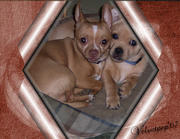Some Chihuahua Information
A Little Bit About Us
We are the Griffin's from Las Cruces, New Mexico, and we have fallen in love with these little dogs. Lucy was our first chihuahua, and we loved her so much that we had to get another, who we named Desi. As a dear friend told us, " You can't have just one!", and she was right. Our chihuahuas are part of our family, and has grown to include Lucy's and Desi's sons, Bob, Pixie, and Dixie. Since we love our chihuahuas so much, we have retired Lucy from breeding. Desi will provide stud services, Bob has been neutered, and Pixie will provide stud services when he is old enough. It is undetermined if Dixie will also stud, or will be neutered as well.
A Little Chihuahua History
The history of the Chihuahua* or Techichi, is traceable back to the ninth century It is likely that it went back to a period prior to the Mayan tribes in the fifth century. Evidence of this little dog's existence during the several centuries the Toltecs who occupied what is now Mexico City dates back to the ninth century. The evidence has firmly established the Techichi to the Toltec period. There are pictures carved in stone still in existence in the Monastery of Huejotzingo, on the Highway from Mexico City to Puebla. The monastery was constructed around 1530 from materials taken from Pyramids of Cholula built by the Toltecs. These carvings give a full-head view and a full picture of a little dog that looks approximately like the Chihuahua of today. There is also some evidence of the little dogs existence in the remains of pyramid constructions at Chichen Itza in distant Yucatan. |
The Myth About the Teacup Chihuahua
For the purpose of showing and record keeping, the American Kennel Club includes the Chihuahua (along with 16 other breeds) in the Toy Group. Therefore, irrespective of their weight or physical stature, ALL Chihuahuas registered with A.K.C. are considered to be a toy breed of dog.
As with all living things, there will be a size variance between individual dogs within this breed. Within the human family, brothers and sisters will differ in height and in weight, as well as other physical attributes. They are described as humans, male or female, and there is seldom if ever a need to break the description down further. The same holds true in regard to the Chihuahua; they are Chihuahuas-Long Coat/Smooth Coat, Male/Female.
Unfortunately, the additional adjectives used to describe the size difference and physical appearances are many; and have been misused for so long they now seem legitimate. Tea-cup, Pocket Size, Tiny Toy, Miniature or Standard - are just a few of the many tags and labels that have been attached to this breed over the years. The Chihuahua Club of America is concerned that these terms may be used to entice perspective buyers into thinking that puppies described in this way are of greater monetary value. They are not; and the use of these terms is incorrect and misleading.
Occasionally, within a litter, there may be a puppy that is unusually small. That puppy is a small Chihuahua and any other breakdown in description is not correct. To attach any of these additional labels to a particular pup is to misrepresent that animal as something that is rare or exceptional and causes a great deal of confusion among those fanciers who are looking for a Chihuahua.
The Chihuahua Club of America does not endorse or condone the use of any of these terms and would caution the perspective puppy buyer not to be misled by them.
We recognize that many Chihuahua fanciers do want the very small puppy. While they are adorable and can be perfectly healthy, the buyer should be cautioned as to the extra care that may be required with regard to their general health and well-being.
Don't Forget to Sign Our Guest Book![]()

